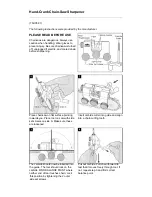
!
WARNING
tO aVOiD PincHing, firMlY HOlD
quick lOck lEVEr wHEn fastEning
accEssOrY. aVOiD Placing HanDs Or fingErs BEtwEEn
lEVEr anD tOOl BODY.
PICTURE 7
A. Clamping flange
B. Accessory holder
5. Turn the Quick Lock™ lever on the top of the tool in a
clockwise motion, to the closed position, to securely lock the
accessory in place (Picture 6).
6. To remove an accessory, simply unlock the clamping
mechanism by turning the Quick Lock™ lever counter-
clockwise as described above (Picture 6).
7. Lift up on the accessory bracket to take it off the pins. (Note:
be careful, blade may be hot.)
NOTE: Some accessories, such as scrapers or blades, may be
mounted either straight on the tool, or at an angle to increase
usability (Picture 5). In order to do this with the Quick Lock™
interface, place the accessory onto the accessory holder making
sure the accessory engages all pins in the holder and the
accessory is flush against the accessory holder. Securely lock the
accessory in place as described previously (Picture 6).
installing anD rEMOVing sanDing
sHEEts
Your backing pad uses hook-and-loop backed accessories, which
firmly grip the backing pad when applied with moderate pressure.
1. Align the sanding sheet and press it onto the sanding plate
by hand.
2. Firmly press the power tool with the sanding sheet against
a flat surface and briefly switch the power tool on. This will
promote good adhesion and helps to prevent premature wear.
3. To change, merely peel off the old sanding sheet, remove
dust from the backing pad if necessary, and press the new
sanding sheet in place.
After considerable service the backing pad surface will become
worn, and the backing pad must be replaced when it no longer
offers a firm grip. If you are experiencing premature wear out of
the backing pad facing, decrease the amount of pressure you are
applying during operation of the tool.
For maximum use of abrasive, rotate pad 120 degrees when tip of
abrasive becomes worn.
Dust ExtractiOn
Your tool can be equipped with a dust port with adaptor for dust
extraction (Picture 9). To use this feature, attach the dust port to
the tool (A) and attach vacuum cleaner to the adapter (B).
usE
gEtting startED
The first step in learning to use the tool is to get the “feel” of it.
Hold it in your hand and feel its weight and balance (Picture 10).
Depending on the application, you will need to adjust your hand
position to achieve optimum comfort and control.
When holding the tool, do not cover the air vents with your hand.
Blocking the air vents could cause the motor to overheat.
PICTURE 10
iMPOrtant!
Practice on scrap material first to see how the
tool’s high-speed action performs. Keep in mind that your tool
will perform best by allowing the speed, along with the correct
accessory, do the work for you. Be careful not to apply too much
pressure.
Instead, lower the oscillating accessory lightly to the work surface
and allow it to touch the point at which you want to begin.
Concentrate on guiding the tool over the work using very little
pressure from your hand. Allow the accessory to do the work.
Usually it is better to make a series of passes with the tool
rather than to do the entire job with one pass. To make a cut, for
example, pass the tool back and forth over the work. Cut a little
material on each pass until you reach the desired depth.
slide “On/Off” switch
The tool is switched “ON” by the slide switch located on the
topside of the motor housing (Picture 1 & 2).
TO TURN THE TOOL “ON”, slide the switch button forward.
TO TURN THE TOOL “OFF”, slide the switch button backward.
Variable speed control dial
This tool is equipped with a variable speed control dial (Picture
11). The speed may be controlled during operation by presetting
the dial in any one of ten positions.
To achieve the best results when working with different materials,
set the variable speed control to suit the job (See Speed Chart).
To select the right speed for the accessory in use, practice with
scrap material first.
PICTURE 11
A. Variable speed slide switch
speed chart, see front Matter.
addendum below:
accessory
application
MM11
Sanding surfaces close to edges, in corners
or hard to reach areas.
Depending on the sanding sheet for, e.g.,
sanding wood, paint, varnish, thinset and
cement.
MM70W
For detail sanding.
MM70P
For sanding primer and removing brush
strokes, drops of paint and paint run.
11












































